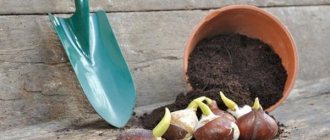Tulips in landscape design
Traditionally, the described crop is planted in flower beds. One landscape composition may contain plants with flowers of the same color scheme or different shades.
The described crop is often grown in planting arrays, where other bulbous plants are also placed, for example, daffodils, muscari, hyacinths. Common ways of using the described plant are in mixborders, ridges, on alpine hills, rocky gardens, and in borders.
Did you know? Today, 92% of all international trade in tulip bulbs is controlled by the Netherlands. 88% of all tulip plantations are located in the same state.
Landscape designers recommend growing the described crop in the following ways:
- In groups: in the same color scheme, using contrasting shades, with a smooth transition from light to rich colors.
- By height: flowers are placed in such a way that none of them obscures the neighboring plant, or in steps - tall ones are located in the background, medium-sized ones are in the center, low ones are in the foreground.
- In containers: pots can be placed at the entrance to your home or placed around the garden.
Favorite flowers
There were times in the history of tulips when their plantations in Holland were guarded by armed police - these flowers, a symbol of wealth and nobility, were so expensive and desirable.
Their triumphal march continues to this day, although more than 350 years have passed since then. The number of varieties continues to grow, and there seems to be no end to it. We have selected only a few of them and offer three planting options.
Properly selected companions , like a beautiful frame, only enhance the charm of tulips. These are pansies, forget-me-nots, daisies, wallflowers. When spring flowers fade, summer flowers will come to replace them.
If the beds and flower beds have to be watered a lot in the summer, the tulip bulbs cannot ripen and quickly rot. Therefore, here it is better to plant tulips in special baskets, and after flowering, remove the baskets and place them in a dry corner, where the leaves will completely wither and the bulbs can ripen.
Or another option: plant drought-tolerant flowers between them , like alyssum or paniculata. These lovers of dry conditions are even useful for tulips, since in summer they draw out excess moisture, which is destructive for the latter, from the soil.
Tulips are also good with other spring-flowering bulbs . Some gardeners like mixed plantings of bulbous plants: hyacinths and daffodils are planted between the tulips of the Triumph and Darwin hybrids groups.
To ensure that they all bloom at the same time, it is better to take late-blooming trumpet daffodils.
The smaller cyclamen daffodil (Narcissus cyclamenius), whose peak flowering occurs in early spring, is suitable for early varieties of Kaufman tulip.
You can plant tulips under bushes of spirea 'Arguta' or forsythia (forsythia) blooming at the same time. Both simple and terry varieties feel good under them and look beautiful.
| The velvety heads of single-color pansies highlight the elegance of the white tulips. | 'Pink Impression', Darwin hybrid tulips |
| Funcias are ideal companions for tulips. Their leaves begin to grow in full force when the tulip bulbs are pulled into the soil. | Classic partners of tulips are forget-me-nots and daisies . What if you plant carnations ? |
Development of tulips throughout the year
When tulip bulbs are planted in the fall, the bulb contains all the substances the plant needs during the initial stage of active growth next spring. It just needs to take root, and for this it is important that the soil is loose.
When a tulip blooms, the supply of nutrients in the bulb runs out, and then the opposite happens: all above-ground green parts of the plant help form replacement bulbs, since the mother bulb dies after flowering.
Therefore, tulip leaves cannot be cut until they turn completely yellow . Only then can you be sure that the nutrients for next spring have accumulated in the newly formed bulb.
But fading flowers need to be cut off so that the formation of seeds does not deplete the plant.
If tulips grew in one place for a very long time and their flowering began to decline, the reason may be due to the large number of children formed. They need to be separated and planted.
| September | April | May |
| June | July | Cutting faded flowers |
Feeding tulips
As soon as the leaves appear, feed the plants with a complete mineral fertilizer with a high nitrogen content. The ripening of the bulbs after flowering will be supported by potassium fertilizer.
This is interesting: Rose Grace
Organic fertilizer is best applied in the fall. Before planting your tulip bulbs, add a handful of bone meal to each hole.
Planting tulips under trees
On lawns or under trees, tulips can look like they are growing wild. For this purpose, small and strong species are selected so that they are not drowned out by grass, hardy so as not to freeze in winter.
It is important not to damage the flowers when mowing the grass. Tulips are planted in unshaded areas so that they can develop to their full potential.
| A sea of tulips spreads out under the treetops. |
Schemes of flower beds with tulips
Tulips look much more interesting if you plant them in a flowerbed not interspersed, but in small groups , 7-10 plants of each variety.
In a flower bed measuring 1 x 1 m, there is a non-double early variety 'Apricot Beathy' (1), a hybrid Kaufman tulip 'Shakespeare' (2), a hybrid Foster tulip 'Pinkeen' (6), a non-double late variety 'Palestrina' (7).
In the first row: pansies (Viola) 'Iceqeen Violett' (3) and 'Roggli Berna Violett' (5), as well as yellowberry (Erysimum) 'Prince Violett' (4).
In order for all the flowers to be clearly visible in the flowerbed, you need to know the height of the varieties.
In our picture, against the background of a spirea bush of the variety 'Grefsheim' (1), there is a Darwin hybrid 'Pink Impression' 60 cm high (2), a lower early terry variety 'Goya' (3), in the foreground is a Greig tulip 'Perlina' (4 ), followed by hyacinth 'Gipsy Queen' (5).
If you want to prolong your joy, plant tulips of different types, blooming not at the same time, but one after another . Among the wild species there are those that bloom at the end of April.
Following them, some botanical species will bloom (Foster's tulip, Greig's tulip and Kaufmann's tulip), and then varieties from the Simple Late group will bloom (mid-to-late May).
In our picture, the 'Braty Queen' (2) tulips from the Simple Early group will later be replaced by 'Fantasie' (3) tulips from the Parrot group. Above them, the Lamarck serviceberry (Amelanchier lamarckii) (1) spreads its tent, and in the first row there are forget-me-nots (4).
When do the bulbs fade?
When the flowering of tulips , daffodils and other spring bulbs ends, a change of scenery begins. The resulting voids will be filled by flowering and decorative foliage plants, which in no case should displace their predecessors.
Spring bulbs form a good partnership with autumn-flowering perennials, such as sedum and autumn asters . In shady corners, the baton of flowering after daffodils will be picked up by spirea 'Arguta'.
Delicate wild tulip species can be safely planted among clumps of aubrieta , ground cover sedum, thyme and other cushion-shaped plants. Firstly, they, like the inhabitants of the alpine hills, love the sun, and secondly, their narrow lanceolate leaves disappear very early.
But the yellowed leaves of cultivated tulips can spoil the decorative appearance of the flowerbed, so it is better to plant, for example, paniculata (gypsophila) next door.
| Swinging paniculata - gypsophila - (Gypsophila) will cover the yellowed leaves of garden tulips with a cloud of fragrant flowers. | Geranium (Geranium) will fill the gaps after the bulbs bloom: tall varieties - on ridges, low-growing ones - on an alpine hill. | The autumn novibelgii aster (Aster novibelgii) begins to grow in late spring, so it is ideal for tulips. |
| sedum | Aubrieta | Thyme |
Source: https://flowers.cveti-sadi.ru/posadka-klumby-tyulpanov/
Tulips in the garden, at the dacha
When cultivated in garden plots, the described flowers are planted in the trunk circles of fruit trees (apple trees, cherries, plums) and shrubs. If this option is not suitable, then a separate area should be set aside for this crop. For many years, row planting has also been used in gardens. To do this, the garden plot is divided into zones and in each of them one variety is planted in a row.
Did you know? For the first time, residents of the Middle Eastern countries began to cultivate tulips. In the 11th century, this plant was a symbol of the culture of the Seljuk tribe.
When dividing a garden into zones, rectangular monoflower beds are also used. The territory of the site is divided into sectors, in each of which flowers are planted in the same color scheme. Such segments combine harmoniously with each other. They enclose the zones with climbing plants. An effective technique is to plant several varieties with different species in clumps in the form of a vernissage along the path.
In addition, you can lay ceramic decor - figured figurines, tiles, etc.
Since perennial onions are combined with tulips, it is good to combine these crops in the garden beds. If the territory of the dacha is large, then the described crop can be allocated a separate corner in the depths of the garden. In the spring, during flowering, it will become a bright spot against the background of young foliage of trees, and in the summer, after losing its decorative effect, it will be hidden behind the greenery of large plants.
Another interesting element is a multi-level flowerbed. It is done by planting tall varieties in the background, medium-growing varieties in the center, and dwarf varieties in the front and along the edges.
It is also possible to plant tulips in the form of a winding path. For such an element, flowers of the same variety and tone, or the same variety, but in contrasting shades, are suitable. The edges should be planted with small plants that shade the tulip path.
Third reception. We use companion plants
You can diversify the planting pattern of bulbous bulbs by using companion plants - flower crops that bloom at approximately the same time. They fill the volume of the flower bed, create a background, and in this frame the bulbs look more juicy and expressive.
Filler plants provide an excellent backdrop. Photo by the author The following are well suited for the role of filler plants: subulate phlox, Douglas phlox, Bieberstein's chickweed, arabis, spring forget-me-not, alyssum, brunnera with its blue flowers, which are so similar to the inflorescences of the delicate forget-me-not. A proven option for an exquisite combination is tulips of “chicken” color or cream colors in the tone of diluted eggnog, planted among the bright “daisies” of Doronicum. These same tulips will sparkle interestingly if you place them next to muscari in heavenly shades, delicate blueberries or among the smoky purple balls of decorative onions.
Decorative bows go well with tulips and daffodils. Photo by the author Universal for flower beds and primroses. The simplest varieties are especially good - the usual white-flowered or Julia primrose. If you combine different varieties, they make absolutely wonderful chintz flower beds. Bouquets of daffodils placed here and there will fit organically into them.
A wonderful chintz flower garden of various primroses. Photo by the author In this case, the bulbs are carefully introduced into the existing flower arrangement. Keep in mind that you will no longer be able to dig them out painlessly. The composition will be destroyed. Therefore, get ready for the fact that the bulbous ones will please the eye for several years, and then disappear. As a consolation, I can say that with this method of planting you will not need a lot of planting material. Even if you select a dozen bulbs for a flower garden, successfully combining them by color, the result will already be impressive. It is better to make such compositions in a monochrome palette - tone on tone, or select varieties based on the principle of effective contrasting combinations.
Spectacular contrasting combinations. Photo by the author
Where is the best place to plant tulips?
At a summer cottage, the crop usually takes place in a flowerbed in front of the windows or the central entrance. It is also planted near an artificial reservoir.
Find out also how to grow tulips in a greenhouse by March 8th.
This flower is also suitable for planting under a garden bench.
An interesting solution would be to install not a traditional wooden bench, but a plastic one, maybe even a transparent one. Another favorite way to grow flowers is along paths.
Video: Unusual planting of tulips
What do tulips go with?
In group plantings, the described crop is recommended to be grown together with the following plants:
- hosta and other perennials with large leaves;
- daylilies;
- phlox;
- geranium;
- steppe almond, holly mahonia, Japanese spirea and other ornamental shrubs;
- common lilac;
- daffodils;
- hyacinths;
- ferns;
- muscari;
- cereals;
- coniferous.
These plants look very impressive when planted against the backdrop of a smoothly trimmed lawn. They are often used for borders - in such a composition they use a combination of tulips with other plants, usually flowering ground covers, as well as tall perennials, which are able to “cover” the flowers after they have lost their decorative effect.
When composing border compositions with tulips, in order to prolong its decorative effect, plants with a short flowering period are planted in baskets, which are removed after flowering. And in their place, “later” annuals are placed.
Care immediately after landing
Once the seeds have been planted, watering is necessary. Sufficient humidity will allow the tulips to develop normally. It is necessary to begin caring for the plant in the spring, as soon as small sprouts have formed. It is worth removing the remains of plants that have died. Tulips love moisture, but they have a rhizome that cannot reach deep into the ground. For this reason, it is important to water in a timely manner.
Many gardeners advise growing such a flower from seeds in greenhouse conditions. In this case, you will not have to touch it for 3 years. If growing occurs in open ground, then it is worth pulling out the sprouts for the winter. And in the spring they are planted in the ground again.
In the new season, the plant renews itself, develops, and new foliage appears. When he turns 3 years old, then he can be divided using the vegetative method, as children begin to form
They should be separated with caution so as not to damage the mother bulb. You will be able to see the first flowering 5 years after planting the seeds.
Young bulbs should be planted according to the following rules:
- Do not deepen them more than 10 cm
- Initially, grooves are made and filled with sand.
- The sand is watered with water to which salt has been added.
It is recommended to initially soak the onions in a solution of potassium permanganate before planting. After this, they are placed in the ground and covered with sand. Owners need to constantly ensure that the beds are clean. To do this, weeds are regularly removed. After all, the plant has not yet grown strong, so the grass can destroy them. You should definitely not forget about watering. Without water, tulips will die.
There are many techniques for this. Young tulips do not need fertilizer. But they will benefit from a little feeding. To do this, it is recommended to add nitrogen and potassium fertilizers to the watering can. Such feeding should be alternated. So, many summer residents fell in love with tulips. Many people want to decorate the area of their dacha with them so that they can enjoy their beauty in the spring. They can be grown not only by dividing the bulbs, but also by seeds. The main thing is to know some rules.
ogorodsadovod.com
Tulip planting patterns
There are many examples of how to plant the described flowers in an original and beautiful way. Below are the most popular of them.
| Scheme 1. Composition shape: rectangular, square, round, corner. | Plants: thuja occidentalis Smaragd, holly mahonia, hostas, tulips with an average flowering period, preferably with double petals of yellow or orange color (Monte Carlo, Sensual touch). |
| Scheme 2. Form of composition: rabatka. | Plants: Darwin hybrids, simple early tulip, Rembrandt-, Triumph-tulip, Armenian muscari. |
| Scheme 3. Form of composition: elongated flower bed. | Plants: hosta, sedum, liatris, tulip, peony, loosestrife, rhizomatous geranium, gaillardia, crocus. |
| Scheme 4. Form of composition: round raised flower bed. | Plants: Konica spruce, rugosa rose, Fortune euonymus, boxwood, juniper, iris, hosta, lavender, hybrid daylily, tulip, Japanese barberry. |
What to plant tulips with so that the flower bed blooms all summer
You can select ornamental plants in such a way that the area looks decorative for a long period. This is achieved by planting crops with different flowering periods and different heights next to each other.
Thus, when the inflorescences of some plants fade, the buds of others will bloom. This order can be achieved if you plant flowers with early, middle and late flowering periods in the flowerbed, and also select herbaceous crops with a long period of preservation of decorative leaves.
Important! Tulips should be grown in the same area for no more than four to five years. In order for them to continue to delight with abundant flowering in the future, they need to be transplanted to another place.
Tulips have a short flowering period - no longer than three to four weeks. The earliest varieties (Christmas Marvel, Montrex, New Design) bloom at the end of April, the middle ones (Denmark, Havran, White Dream, Barcelona) - in mid-May, and the late ones (Finola, Statement, Orange Angelica, Cafe Naur) - at the end of May . By planting 8–10 bulbs of each of these varieties, you can ensure that the flowerbed will delight you with lush flowering for 1–1.5 months.
To ensure that the flower garden remains decorative in the future, you can plant the following plants:
- host;
- astilbe;
- Brunner;
- forget-me-nots
It is these plants that begin to bloom when the tulip buds dry out. If bulbs are dug up, then salvia, aster, marigolds, lobelia, and ageratum can be planted in their place.
So, the use of tulips on the site allows you to obtain beautiful and original decorative compositions. You can come up with unusual planting schemes yourself or use ready-made solutions. In order for flowers to be healthy and grow well, it is necessary to carry out proper planting and provide timely, high-quality care.
How to arrange tulips with other plants
Which flowers are best to plant tulips next to depends on the size of the plot and the tastes of the gardener. Bulbs are ideally combined with other primroses, coniferous perennials and other plants.
See also
Description of mixtures of cut varieties of Chinese asters, rules of planting and cultivation
Read











